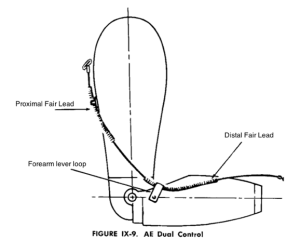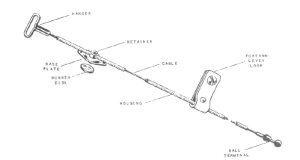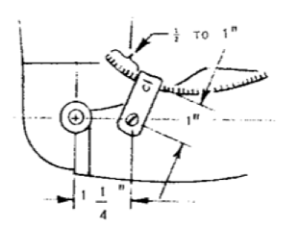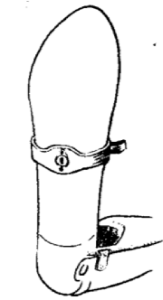Fairlead Cable (aka Dual-Control Cable / Split Cable)
The split-housing control cable system consists of a cable held in place and guided by two separate lengths of housing. The pieces of housing are fastened with retainers at points where the cable must be supported or operated through an angle. When force is transmitted through the housing and cable, side forces are exerted on the fairleads where the cable bends through an angle. The fact that these forces are exerted where the cable operated through an angle is used as an advantage in the transhumeral dual-control system. With the forearm adjusted in 10 degrees of initial flexion (so that it’s maximum extension is 10 degrees short of full extension), the control cable operates causes a force to be exerted on the lever loop to flex the forearm.
The maximum force obtained would not be enough to enable the individual to handle many objects on the basis of “live-lift”. In most cases the person flexes the forearm to the position desired, locks the elbow, then grasps the object to be lifted.[1]
Component Parts
The control system assembly for a transhumeral body powered prosthesis consists of the cable, split-housing, hanger, retainer, baseplate and rubber disc, leather lift tab, and ball terminal. The control system may be constructed with standard or heavy-duty parts. This cable is interchangeably called a split-cable housing or dual-control cable or fair-lead cable
The cable runs from the control attachment strap of the harness to the baseplate on the humeral section then in front of the elbow joint to the forearm lift tab to the TD.
There are two lengths of housing positioned above and below the elbow axis. The cable housing is a guide or channel for the transmission of force by the cable.
The split housing allows for two separate functions: TD operation and Elbow flexion.
The two lengths of housing are attached to the prosthesis via two fairleads: the baseplate/retainer and the forearm lever loop. The fairleads act as “reaction points” as the cable bends through the housing.
 |
 |
The location of the fairleads (reaction points) affects the required force and excursion to operate the prosthesis.
Forearm lift tab location
|
 |
Base Plate and retainer
To find the placement: Draw two vertical lines: one on the lateral side through the elbow axis and one on the posterior side of the socket. Draw the midline. |
 |
- New York University, Upper Limb Prosthetics, 1979 revision ↵
A fairlead is a device that guides a line, rope, or cable around an object or structure
